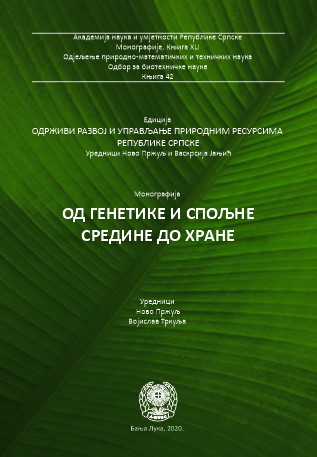Local and global strategies for viticulture and wine production in the Republika of Srpska
DOI:
https://doi.org/10.7251/EORU2001609CAbstract
Viticulture and winemaking are branches of which about 5% of the world's population lives. Total world acreage under vineyards is 7.5 million hectares. Spain has the largest acreage under vineyards in the world with 969,000 hectares, and the largest wine producer is Italy with 54.8 million hectoliters of wine. Bosnia and Herzegovina has about 3,257 hectares (wine varieties) under vineyards, produces 29.650 tonnes of grapes and 17.74 million litters of wine, of which in the Republic of Srpska there are about 565 hectares under vineyards, estimated production is about 5.500 tonnes of grapes and production is about 3.24 million litters of wine. Viticulture in the Republic of Srpska is a branch with currently a small share in the structure of total agricultural production, but with great potential for further development. The reionization of viticulture production is the basis of all activities aimed at improving viticulture and winemaking. Viticulture and wine production in the Republic of Srpska is characterized by two climatically separate distinct winegrowing regions; the Herzegovina region and the northern part region of the Republic of Srpska. Viticulture and winemaking of Herzegovina with far more favorable climatic characteristics (Mostar vineyards) produces grapes and wine of varieties of more southern type, such as white autochthonous varieties: Žilavka and Bena, white introduced varieties: Chardonnay, Smederevka and Tamjanika and black varieties: Vranac, Merlot, Cabernet Sauvignon, Syrah, Pinot Noir, and providing wines for the most demanding consumers. The high quality wines of the Herzegovina – part of the Republic of Srpska, have long been known both on the domestic and foreign markets. Viticulture and winemaking in the northern part of the Republic of Srpska (Kozarac, Ukrinsko and Majevice vine growing areas) has begun with the restoration of the vineyards since 2004. Wine culture is slowly, but surely, finding its place in this region. Thanks to a private initiative through the raising of vineyards and the opening of family cellars, modern vineyards with classic varieties such as white wines are being raised: Chardonnay, Pinot Blanc (Burgundy white), Riesling, Sauvignon Blanc, Incense, Welschriesling (Graševina, Riesling Italian) and red wine: Cabernet Sauvignon, Merlot, Frankovka, Syrah, Pinot Noir (Burgundy Black), Gamay. The traditional interspecies hybrids of the latest generation, more resistant to low winter temperatures and diseases, such as Panonia, Morava, and others, are not far behind the classic varieties. The main problems in grape processing, wine production and its storage are the lack of modern technology for grape processing, as well as the production of high quality wines at many wineries. The high cost of equipment, grape processing equipment necessary for the production of high quality wines, insufficient supply and high cost of quality packaging, oenological experts and other inputs in winemaking are very often a limiting factor for most producers, especially those with smaller production capacities. With the increase in wine production, there is a need for skilled staff to produce high quality wine. Although certain wines from the region of Herzegovina bear the epithet of wines with a geographical origin, the procedure for the protection of the origin of wines in the the Republic of Srpska is not appropriate and in accordance with the standards necessary for such qualification. In order to promote scientific research at the Faculty of Agriculture, University of Banja Luka, within the Institute of Horticulture, there is also a Laboratory for ampelography and wine production. Activities have been initiated to find and identify indigenous vine varieties of the Republic of Srpska, where the Institute for Genetic Resources of the University of Banja Luka is a coordinating institution. Effective management of viticulture production can contribute to a better utilization of natural resources, especially uneven terrains and localities favorable for vineyard cultivation and overall rural development. Viticulture production is also, with its supporting elements, an excellent prerequisite for the development of various forms of tourism related to wine production. In parallel with the development of production, it is also necessary to work on the development of the market for wine and wine products, through generic product differentiation strategies, promoting market and business initiatives. It is important to direct consumers to wines and wine products as different and high value products. To bring consumers closer to the culture of drinking wine and wine products, especially among younger consumer groups, while promoting the socially responsible consumption of wine and wine products. Of particular importance is the need to connect small farmers into a single cluster that will enter the market with a unique and distinctive product. The condition for progress is to bring together, on a horizontal and vertical level, all the participants involved in the viticulture and wine industry.
